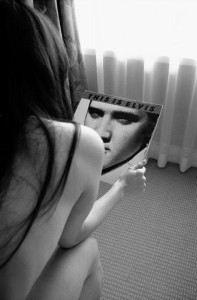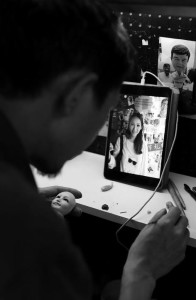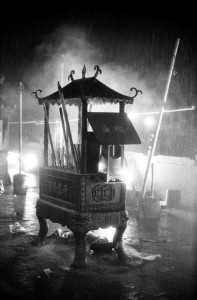Andy Summers, photographer and guitarist of The Police, talks with Hannah Levin from The Home Stretch about art, music, the creative process and specific images below. Andy is in Tucson for the opening reception of Light Motifs, photographs by Ralph Gibson and Andy Summers, at Etherton Gallery, Saturday, September 19th, from 7 to 10pm. The exhibition runs through November 7th at 135 South 6th Avenue.



images copyright Andy Summers and courtesy of Etherton Gallery
In our season opener, Light Motifs, Etherton Gallery presents work by photographers Ralph Gibson and Andy Summers, two artists who gamely walk the thin line where abstraction leans into reality.
Gibson — known for his graphic, elegant surreal eye — will show work from his new series, Political Abstraction, which craftily subjects mysterious color images into conversational diptychs, a body of work he calls the most “abstract, demanding and dangerous” project he has worked on. Also on display we present his large-scale nudes that take you on a luxurious trip along the lines of the female form.
Summers, well-known as the guitarist for The Police and his own extraordinary solo musical career, has been taking photographs since the 1970s and cites Gibson as an early influence on his work. His photographs intriguingly delve into the surreal with a crisp eye that seduces the viewer to construct the open-ended story.
Meet the artists at the reception where they will be on hand for a book signing featuring out-of-print books, including Nude by Ralph Gibson and Desirer Walks the Streets by Andy Summers.
LECTURE
The Etherton Gallery Distinguished Lecture Series at the Center for Creative Photography
presents Ralph Gibson speaking at 5:30 pm, Friday, September 18, 2015.
Light Motifs:
Photographs by Ralph Gibson & Andy Summers
| Exhibition: | Light Motifs: Ralph Gibson & Andy Summers |
| Dates: | September 15 – November 7, 2015 |
| Opening Reception: | Saturday, September 19, 7-10pm |
| Location: | Etherton Gallery 135 S. Sixth Avenue |
| Gallery Hours: | 11 – 5 Tuesday through Saturday and by appointment |
| Contact: | [email protected], 624-7370 |
Etherton Gallery is pleased to present Light Motifs: Photographs by Ralph Gibson and Andy Summers, on view from September 15 through November 7, 2015. Legendary photographer Ralph Gibson will introduce a new body of work Political Abstraction, and a selection of large-scale photographs of nudes, shown only at Paris Photo Los Angeles by Etherton Gallery in May 2015. Photographer, writer and musician Andy Summers, best known as a member of the band, The Police, will show a selection of photographs made over the last twenty years in conversation with Gibson’s work. Light Motifs explores the aesthetic affinities that unite their poetic and otherworldly images. Etherton Gallery will have a limited number of the artists’ books for sale, including Ralph Gibson’s Political Abstraction (University of Texas Press, 2015) and Nude (Taschen, 2009) and Andy Summer’s I’ll Be Watching You: Inside The Police (Taschen, 2007) and Desirer Walks the Streets (Nazraeli, 2009). Both photographers will attend the opening reception and sign books at 7-10pm on Saturday, September 19, 2015.
Ralph Gibson will speak about his career and his new series, Political Abstraction at 5:30pm on Friday, September 18, 2015 at the Center for Creative Photography Auditorium at the University of Arizona.
Long standing friends, Gibson and Summers share an interest in the legacy of Surrealism and their work is firmly rooted in their personal experiences. Gibson uses a Leica to make elegantly lit, close-cropped straight photographs permeated with a beautiful grain. The iconic MJ, Sardinia, offers a close up portrait of Gibson’s partner, Mary Jane at the beach, reminiscent of English photographer, Bill Brandt (1904-1983). MJ’s tanned arm holds a towel over her eyes to block out the sun. Photographer’s wives have often been the subject of their pictures, notably Edith Gowin and Eleanor Callahan, but MJ is not only Gibson’s muse, she is an essential participant in the artistic process. Gibson’s staged photograph highlights what curator Keith Davis describes as “the tension between pictures and the world.” We see MJ through the lens of Gibson’s desire, always mysterious and out of reach.
Gibson’s new project, Political Abstraction is a series of diptychs, in which he builds meaning by juxtaposing a black and white and color image in a single print, each image separated and surrounded by a wide white border. He constructs elegant compositions using simple, seemingly unrelated subjects, such as an exit sign and a cactus. However, each image bears an affinity to the other through lyrical formal correspondences, not unlike pages in a book, which produces a more complex viewing experience. This is not surprising since in 1969, Gibson founded Lustrum Press, the influential small publisher. The brilliance of Political Abstraction is that Gibson simultaneously invokes the randomness of images found online, but grounds each diptych in the selection, editing and constructed narrative of the photo book.
Light Motifs includes a selection of photographs by Andy Summers made over the past twenty years. Summers’ early work presented the alienation and utter absurdity of life on the road with the Police and provides a fascinating glimpse into the rarified and occasionally claustrophobic world of a rock star. His recent work has the power of European surrealist photographers of the 1920s and 30s such as Brassaï whose work captured the dark side of Parisian life. Summers’ subject matter takes us far afield to Japan and China in grainy, nocturnal, street images, which have an hallucinogenic quality.
One of Summers most resonant images, Elvis Fan, Tokyo, features a seated naked woman with long dark hair, photographed from behind, staring at Elvis Presley’s face on the cover of the posthumous album, This is Elvis. The record and a documentary film were released in 1981 at the same time that the Police released their blockbuster fourth album, Ghost in the Machine. Elvis Fan offers the viewer much to consider; it plays on sexual stereotyping and presents a cautionary tale about the ephemeral nature of stardom and its costs. Summers plays on René Magritte’s famous painting of a pipe, under which he wrote, “This is not a pipe” from the series called The Treachery of Images. Like Magritte and Gibson, Summers highlights the tension between “pictures and the world,” suggesting that photography is merely a representation and not reality. Even a man as relentless photographed as Elvis, is not revealed through his image. Photography is by its nature reductive and abstract, unable to convey the details that make up a life even though it simultaneously marks the presence of the photographer. It is opaque and cannot be read like a play list.
For more information about Light Motifs: Photographs by Ralph Gibson and Andy Summers, please contact Daphne Srinivasan, Hannah Glasston or Terry Etherton at Etherton Gallery at (520) 624-7370 or [email protected] or visit our website at www.ethertongallery.com. Etherton Gallery is located at 135 S. 6th Avenue in downtown Tucson.
For information about Ralph Gibson’s talk at the Center for Creative Photography on September 18th, please call 520-621-7968 or email [email protected] or visit their website at www.creativephotography.org The Center for Creative Photography is located on the campus of the University of Arizona at 1030 North Olive Road. Admission is free.
x x x
Artist Bios
Ralph Gibson
Ralph Gibson was born in Los Angeles, California. He served as a photographer’s mate in the U.S. Navy from 1956 to 1960. After his service he studied painting and photography at the San Francisco Art Institute from 1960-61. In 1961-1962, he worked as a printing assistant to photographer Dorothea Lange. It was Lange who gave him the most important advice of his career – to find his “departure point.” In 1963, he moved back to Los Angeles. Between 1967 and 1969, Gibson assisted Robert Frank on the film, Me and My Brother. Starting with The Strip (Los Angeles, 1966), he began to publish his work in book form, though the reception of his first volumes was poor. His photographs of this early period were in a documentary style influenced by Frank, Henri Cartier-Bresson and William Klein, and in fact, Bruce Davidson and Mary Ellen Mark presented him to Magnum Photos for membership consideration.
According to Gibson, he began to understand his “departure point,” when in the process of analyzing his documentary work, he realized that his interest in the hand was a common thread throughout much of his work. Gibson was unable to sell his first book of this new work to a publisher. In 1969, Gibson moved to New York, where he formed Lustrum Press in order to exert control over the reproduction of his work. His images often incorporated fragments with erotic and mysterious undertones, building narrative meaning through contextualization and surreal juxtaposition.
A shift in Gibson’s work appeared in the 1970s and he began to create surreal images, published in book form for which he is best known. In 1970, he published The Somnambulist, followed in 1972 by Déjà-vu, and in 1974 by Days at Sea. These works established Gibson’s career in creative photography. The control he exercised over each publication enabled him to organize the images associatively in the manner of a dream sequence. Both the individual black-and-white photographs, printed in high contrast, and their arrangement made use of enigmatic juxtapositions, reflecting the influence of Surrealism. In 1975, Gibson’s work moved away from books toward exhibitions. He joined Castelli Graphics the same year, and had his first exhibition there, Quadrants, in 1976. Since the early 1970s, Gibson’s photographic series have been published in over 20 books, including: Syntax (1983), Tropism (1987), L‘Anonyme (1987), and L’Histoire de France (1991). Political Abstraction (Lustrum Press) is forthcoming in 2015. Gibson divides his time between New York and Paris.
Gibson’s work is included in important collections including; The Museum of Modern Art, the Whitney Museum of Modern Art, the International Center for Creative Photography, Museum Ludwig, Cologne, West Germany and the Stedelijk Museum, Amsterdam among many others.
Andy Summers
Andy Summers rose to fame in the early 1980’s as the guitarist with the multi-million record selling rock band The Police. The Police were the number one band of the time and dominated the music scene and the media in the eighties with several number albums and singles including Every Breath You Take, Roxanne, Don’t Stand So Close to Me, Every Little Thing She Does Is Magic, Invisible Sun, and Message in a Bottle. The band was the recipient of several Grammys and awards too numerous to mention.
Andy Summers innovative guitar playing created a new paradigm for guitarists in this period and has been widely imitated ever since. Prior to the Police, Andy Summers played with various bands in the London scene including the Soft Machine, Kevin Coyne and also Kevin Ayers.
Post Police Andy has made thirteen solo records, collaborated with many other musicians and toured the world as a solo artist. In addition he has composed film scores, and along with many photo gallery exhibitions published books of his photography.
In 2006 his autobiography One Train Later was released to great success and was voted the number one music book of the year in the UK. The film Can’t Stand Losing You based on the book saw it’s theatrical release in the US by Cinema Libre in March 2015. The DVD of the film will be released on July 14th 2015, along with Andy’s latest CD – Metal Dog.
Recent projects include the record Circus Hero from his new band Circa Zero released in April 2014, touring in Brazil with Rodrigo Santos and scoring music for the Turkish film And the Circus Leaves Town.
Summers’ work has been the subject of numerous photo exhibitions at the Leica gallery in Los Angeles, Paris/LA Independent Photo Show, Kunst Licht gallery in Shanghai, CCC Gallery in Beijing and Photokina in Cologne, Germany. In 2015, photography exhibitions are scheduled for August in Sao Paulo Brazil and Rio de Janeiro with Globo newspaper.
Andy Summers is in the Rock and Roll Hall of Fame, the Guitar Player Hall of Fame, has the keys to New York City! He has been awarded the Chevalier De L’Ordre Des Arts et Des Lettres by the Ministry of Culture in France.